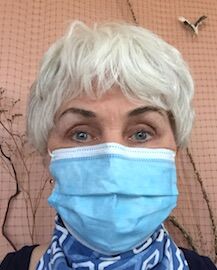Anger
Can You Look Above the Mask?
Have you tried looking into one’s eyes when a mask hides the lower face?
Posted July 18, 2020

To wear a mask is not something I’ve ever needed to do except to prevent inhaling dust. In those situations, I preferred bandana coverings as they were symbolic of the brave, strong pioneer cowboys in movies of my youth. The mask I wear now is to prevent something far more dangerous than dust. It’s worn out of fear and out of concern for mutual, possibly lethal, viral contamination. I’ve had to adjust for the sake of all of us.
I have hearing loss. It’s not easy to understand what someone says when I can’t see a mouth to help distinguish words. It can be frustrating, but still, I know the talking person must wear their mask—for the sake of all of us.
I’ve had to give up using facial lotions and cleansing products that have fragrances. So-called fragrances can become stench for my own nose when trapped inside a mask too long! I have become aware of how much I try to conceal my wrinkling skin and aging spots. Now, instead of makeup, I mask-up—for the sake of all of us.
Still, I really miss seeing smiles and all the subtle facial movements that reveal a person’s feelings and intent. The lower face area has long been the socially accepted place to look at someone during a conversation. Now when I look there I see nearly motionless colors and/or design patterns. I have an urge to say “thank you” to strangers who wear masks and often do to the store clerks and others in service to the public. Yet, I found myself one day feeling annoyed at someone and suddenly realized I was talking in an unkind tone, as if the mask gave me permission to do so. I was aghast at myself! Last time for doing that!
There is an option. One can look above the mask and into a person’s eyes (even if through glasses). I grew up believing that to look into someone’s eyes other than very briefly was impolite and too intimate. It’s like I was taught to wear a gauzy mask over my own eyes lest I see too much. Nonetheless, I learned to look into eyes because of the subtle information they provide and the beauty of a sincere, deep connection it can elicit. To look into someone else’s eyes is an invitation for them to return the same. (Please note that I am not advocating nasty or lewd stares!)
I believe I was in an English course in high school when I first read this line in an assignment: “The eyes are windows to the soul.” I was struck by the beauty of the metaphor and longed to have such an experience. What, I wondered, would it be like if two people looked into each other’s souls? Impolite or not, I wanted to know. As time went on, the significance and variety of my visual connections expanded. Not all were good. What I now cherish most is when my eyes are exchanging truth, trust, and love—soul to soul.
When someone wears a mask and there is no lower face to signal between us, I have begun to look more at eyes. That can include the tissue around the eyes—like the forehead above the nose. Is it crunched together in anger or curiosity? Are the eyebrows raised in surprise or joy? Then there is the area around the outer edges of the eyes. Does a smile push the tissue up from behind the mask?
The eyes are rich with information.1 Yet I find myself looking at the masked area below as if practice would magically enable me to see through the cloth. I remind myself that everyone has probably been wearing invisible masks all along: smiling masks to hide our pains, friendly masks to hide our ill-intentions, and so many other subtle coverings. I feel frustrated looking into a real mask rather than a face. I keep reminding myself it truly is necessary and worth any inconveniences—for the sake of all of us.
I think this is the time to look more into each other’s eyes, directly into the eyes with as much kindness and loving connection as possible. I’m suggesting we give each other permission to share these difficult times with direct eye contact to express the best of our shared humanity and our commitment to help each other.
Can I do this myself? Can I look kindly into the eyes of the woman in the store trying to shove her cart in front of mine and tell her the line is behind me? Can I look lovingly into the eyes of friends I haven’t seen in a while and tell them how much I have missed them? Can I look without teardrops falling while I ask how someone who lives alone has been doing? In how many situations have I bypassed opportunities to connect through eyes to see our fundamental togetherness is still visible? Can I look into the eyes of someone not wearing a mask as my eyes gently, silently plead: “please do—for the sake of all of us.”
I don’t know yet what I am capable of, because this is a new way to interact and form a connection with another human. What I know is that it is time for me to speak with my eyes and look into the windows of other souls. Maybe wearing our masks is an opportunity for all of us to see our shared humanity from that view.
© B. A. Luceigh, July 18, 2020
References
1 There is a field of study that interprets meaning in people’s eyes. Here is an example for more information: To Read Someone’s Mind, Look into Their Eyes
Footnote: For those who are blind, I wonder: could sound and touch be the “winds of the soul?”




